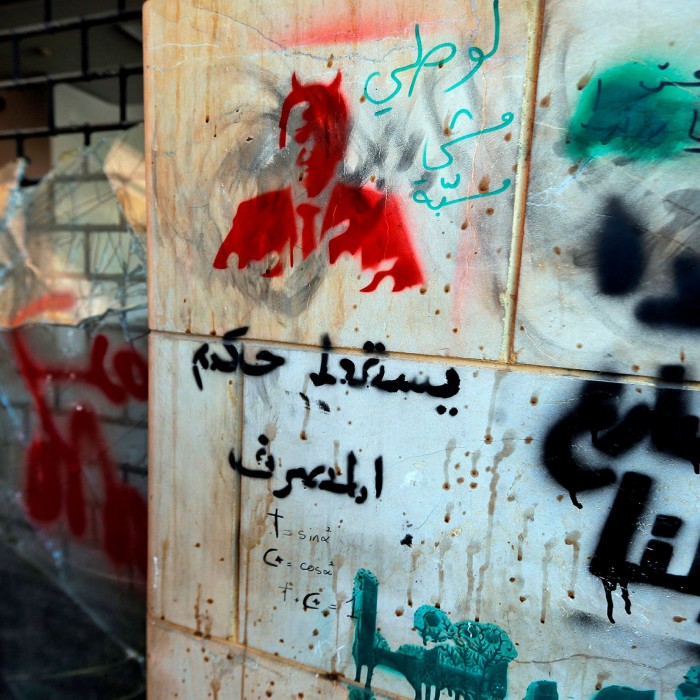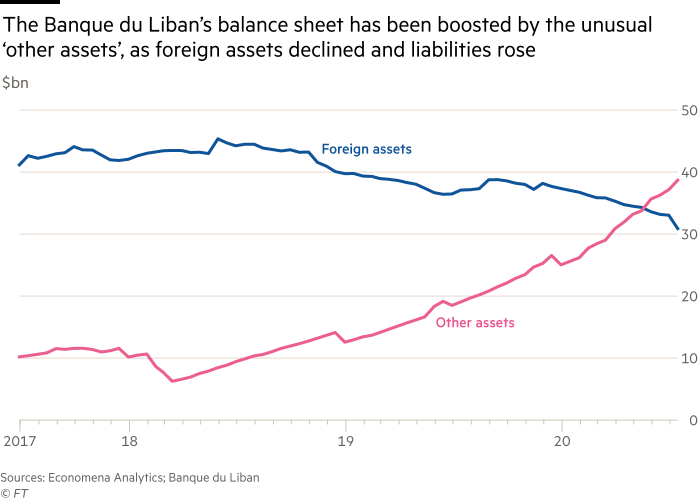Lebanon central bank chief in spotlight over $6bn boost to assets

Roula Khalaf, Editor of the FT, selects her favourite stories in this weekly newsletter.
Lebanon’s central bank chief arbitrarily boosted the institution’s assets by at least $6bn using unorthodox accounting measures as the country’s financial system careered towards collapse, leaked financial statements indicate.
The 2018 audited statements, a copy of which was seen by the Financial Times, reinforce concerns that Riad Salame, the veteran Central Bank of Lebanon (BdL) governor, relied on shifting accounting practices to swell the bank’s assets and balance its books as risky liabilities grew.
The accounts, which were signed off by auditors EY and Deloitte with qualifications on June 30 this year and have not been made public, record an asset worth L£10tn ($6bn) for “seigniorage on financial stability”, whose value “the governor determines . . . as deemed appropriate by him”, according to the financial statements.
But two independent central banking experts said they had never heard of such an accounting measure and raised concerns that seigniorage — which typically refers to profits made when a bank prints money — might be being erroneously used to obscure losses.
“This is too bizarre for words,” said Willem Buiter, former Citigroup global chief economist, academic and central banking specialist. “It is just a way of accounting to artificially blow up the assets of the central bank and hide [its] massively negative net worth or capital.” He added: “Many of the assets are inventions.”
Joerg Bibow, an economics professor at Skidmore College, New York, said it was highly unusual that the governor’s judgment should be used to determine an asset’s value, as they are normally defined by standardised accounting rules. “I’ve never heard that the governor can make up a number,” he said.
The BdL did not respond to requests for comment. Deloitte declined to comment and EY did not respond to requests for comment.
For decades, Mr Salame, the BdL’s longest-serving governor with 27 years in the post, has been credited with steadying the country’s finances during the violent conflicts that wracked Lebanon and the surrounding region and in spite of successive Lebanese governments failing to enact reforms.


But now he faces some of the blame for Lebanon’s worst economic crisis since its civil war ended 30 years ago. A currency collapse is wiping out savings and fuelling runaway price rises, while unemployment has soared and living standards have slumped. According to the Lebanese government, the BdL holds losses of $50bn.
Seigniorage profits are usually accounted for as an income stream, said Mr Bibow. However, the BdL took a different approach, recording expected profits from seigniorage as an asset.
In April, the BdL defended its use of future profits as assets, saying it “does not consider these amounts as losses”. But Hicham Safieddine, lecturer at King’s College London and author of a book about Lebanon’s financial sector, argued that “using projected future profits to balance [BdL accounts] . . . is misleading”.
Since 2009, even the BdL’s unorthodox definition of seigniorage has gone beyond the conventional connotation of currency production, to add L£18tn in expected future profits from its holdings of Lebanese government debt, and finally in 2018 including an expected profit generated by “financial stability” as valued by the governor.
Added to that highly unusual version of seignorage accounting is another contentious item on the BdL’s $150bn balance sheet: ‘other assets’, which have sparked controversy and raised concerns about transparency.

The “other assets” value has almost quadrupled since 2018 — from $10bn to $38.6bn in June 2020, according to Blom Bank research. They now outweigh the BdL’s foreign assets, which have dropped to $30bn, but offset growing liabilities.
The BdL’s interim balance sheet says “other assets” includes seigniorage, allowing it to book more assets, the 2018 financial statements show.
It is unclear what else “other assets” includes, besides seigniorage and “open market operations” — the BdL’s trading of currency and government debt — which is “causing more suspicion that the books are cooked”, said Mr Safieddine.
“Other assets” have grown as on the other side of the balance sheet, the BdL’s debts swelled as Mr Salame turned to an unconventional monetary policy he dubbed “financial engineering” to boost reserves, steady the banking sector, maintain the currency peg and fund the government.
Starting in 2016, the opaque and complex swaps between commercial banks and the BdL, which involved dollar deposits, loans in Lebanese pounds and sovereign debt purchases, have been labelled by critics as akin to a “Ponzi scheme”. The government’s economic recovery plan says Lebanon’s banking system is insolvent.
Mr Salame has defended the BdL’s accounting practices, saying in a speech in May: “We had to have the financial engineering to get time so that Lebanon does not collapse” and that “we didn’t do anything that’s not agreed on internationally”.
The 2018 financial statements suggest how far financial engineering operations were deepening the BdL’s debts as Lebanon’s economic situation started to deteriorate.
The BdL’s high interest debts to banks and financial institutions leapt by about 25 per cent during 2018, from L£161tn in 2017 to L£201tn in 2018. Two Lebanese economists familiar with the BdL’s finances said the growing liabilities were most likely the result of expanding financial engineering. The people asked not to be named because they work for organisations involved with the central bank.
The financial engineering involved paying very high interest rates to attract dollars, with one such deal earning banks as much as 17 per cent interest, according to the IMF. That sucked in deposits totalling $24bn between autumn 2017 and February 2019, according to IMF data — equivalent to more than a third of Lebanon’s $56.4bn gross domestic product in 2018. It boosted the BdL’s foreign currency reserves and triggered big profits for often struggling local banks.
The 2018 statements reveal that the BdL’s relationships with the banks went beyond financial engineering, encompassing multimillion-dollar real estate and asset-backed debt deals.
Last year, the IMF warned Lebanon that the BdL’s unconventional measures to keep dollars flowing were becoming ever more risky and expensive. Even though commercial banks had locked up more than half their assets in its vaults, the BdL’s efforts to maintain foreign exchange reserves were flagging. It lost about $4bn of hard currency reserves in 2018, the IMF said.
“The BdL has been the linchpin of financial stability,” the IMF said in its assessment of Lebanon’s economic health published in October 2019, “but at the cost of intensifying sovereign-bank linkages, which pose risks to banking sector stability, and weighing down its balance sheet while protecting banks’ profitability”.
Letter in response to this article:
Comments